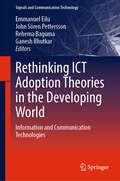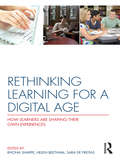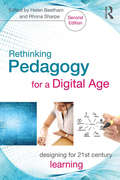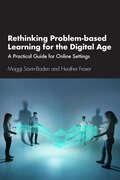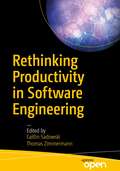- Table View
- List View
Rethinking ICT Adoption Theories in the Developing World: Information and Communication Technologies (Signals and Communication Technology)
by Emmanuel Eilu Ganesh Bhutkar Rehema Baguma John Sören PetterssonThis book provides extended frameworks and models to help with the adoption of information and communication technologies (ICT) in developing countries. The book first discusses the extent to which conventional ICT theories can be rigid in nature, often unable to handle the constant advances in technology, and technology adoption, implementation, usage, and disposal, not to mention different needs and cost availability in developing countries. The authors go on to show how new and revised models, tested in many societies in developing countries, can solve this mismatch. The authors provide examples of successful ICT adoption in developing country settings, in the areas of agriculture, culture, forestry, education, economics, health, and governance. The authors also show how techniques from persuasive design, philosophical designs, and motivational designs have been adjusted to facilitate successful ICT adoption, implementation, usage, and disposal in targeted regions.
Rethinking Innovation and Design for Emerging Markets: Inside the Renault Kwid Project
by Christophe Midler Bernard Jullien Yannick LungThe authors have put together a fascinating narrative of the creation process of one of the most successful example of frugal engineering in recent years. They bring out insightful details of what managerial, organizational and technological pathways were taken to come up with a disruptive innovation that has the potential to change the entry-level automobile market in India and other emerging markets. The book significantly deepens and extends the knowledge of disruptive and reverse innovation, as well as of strategic alliance management. The book keeps the reader captive and is a must read for all who have an interest in innovation.
Rethinking Innovation and Design for Emerging Markets: Inside the Renault Kwid Project
by Christophe Midler Bernard Jullien Yannick LungThe authors have put together a fascinating narrative of the creation process of one of the most successful example of frugal engineering in recent years. They bring out insightful details of what managerial, organizational and technological pathways were taken to come up with a disruptive innovation that has the potential to change the entry-level automobile market in India and other emerging markets. The book significantly deepens and extends the knowledge of disruptive and reverse innovation, as well as of strategic alliance management. The book keeps the reader captive and is a must read for all who have an interest in innovation.
Rethinking Knowledge Management: From Knowledge Objects to Knowledge Processes (Information Science and Knowledge Management #12)
by Claire R. McInerney Ronald E. DayThis book readdresses fundamental issues in knowledge management, leading to a new area of study: knowledge processes. McInerney’s and Day’s superb authors from various disciplines offer new and exciting views on knowledge acquisition, generation, sharing and management in a post-industrial environment. Their contributions discuss problems of knowledge acquisition, handling, and learning from a variety of perspectives.
Rethinking Law, Regulation, and Technology (Rethinking Law series)
by Roger BrownswordThis insightful book presents a radical rethinking of the relationship between law, regulation, and technology. While in traditional legal thinking technology is neither of particular interest nor concern, this book treats modern technologies as doubly significant, both as major targets for regulation and as potential tools to be used for legal and regulatory purposes. It explores whether our institutions for engaging with new technologies are fit for purpose.Having depicted a legal landscape that includes legal rules and principles, regulatory frameworks, technical measures and technological governance, this thought-provoking book presents further exercises in rethinking. These exercises confront communities with a fundamental question about how they are to be governed—by humans using rules or by technical measures and technological management? Chapters rethink the traditional arguments relating to legality, the rule of law, legitimacy, regulatory practice, dispute resolution, crime and control, and authority and respect for law. Examining the role of lawyers and law schools in an age of governance by smart technologies, Rethinking Law, Regulation, and Technology will be a key resource for students and scholars of law and technology, digital innovation and regulation and the law.
Rethinking Learning for a Digital Age: How Learners are Shaping their Own Experiences
by Rhona Sharpe Helen Beetham Sara de FreitasRethinking Learning for a Digital Age addresses the complex and diverse experiences of learners in a world embedded with digital technologies. The text combines first-hand accounts from learners with extensive research and analysis, including a developmental model for effective e-learning, and a wide range of strategies that digitally-connected learners are using to fit learning into their lives. A companion to Rethinking Pedagogy for a Digital Age (2007), this book focuses on how learners’ experiences of learning are changing and raises important challenges to the educational status quo. Rethinking Learning for a Digital Age: moves beyond stereotypes of the "net generation" to explore the diversity of e-learning experiences today analyses learners' experiences holistically, across the many technologies and learning opportunities they encounter reveals digital-age learners as creative actors and networkers in their own right, who make strategic choices about their use of digital applications and learning approaches. Today’s learners are active participants in their learning experiences and are shaping their own educational environments. Professors, learning practitioners, researchers, and policy-makers will find Rethinking Learning for a Digital Age invaluable for understanding the learning experience, and shaping their own responses.
Rethinking Learning for a Digital Age: How Learners are Shaping their Own Experiences
by Rhona Sharpe Helen Beetham Sara de FreitasRethinking Learning for a Digital Age addresses the complex and diverse experiences of learners in a world embedded with digital technologies. The text combines first-hand accounts from learners with extensive research and analysis, including a developmental model for effective e-learning, and a wide range of strategies that digitally-connected learners are using to fit learning into their lives. A companion to Rethinking Pedagogy for a Digital Age (2007), this book focuses on how learners’ experiences of learning are changing and raises important challenges to the educational status quo. Rethinking Learning for a Digital Age: moves beyond stereotypes of the "net generation" to explore the diversity of e-learning experiences today analyses learners' experiences holistically, across the many technologies and learning opportunities they encounter reveals digital-age learners as creative actors and networkers in their own right, who make strategic choices about their use of digital applications and learning approaches. Today’s learners are active participants in their learning experiences and are shaping their own educational environments. Professors, learning practitioners, researchers, and policy-makers will find Rethinking Learning for a Digital Age invaluable for understanding the learning experience, and shaping their own responses.
Rethinking Pedagogy for a Digital Age: Designing for 21st Century Learning (PDF)
by Helen Beetham Rhona SharpeThrough a critical discussion of the issues surrounding the design, sharing and reuse of learning activities, the second edition of Rethinking Pedagogy for a Digital Age examines a wide range of perspectives on effectively designing and delivering learning activities to ensure that future development is pedagogically sound, learner-focused, and accessible. This powerful book: • examines the reality of design in practice • shares tools and resources to guide practice • analyses design within complex systems • discusses the influence of open resources on design • includes design principles for mobile learning • explores practitioner development in course teams • presents scenarios for design for learning in an uncertain future Illustrated by case studies from across disciplines and supported by a helpful appendix of tools and resources for researchers, practitioners and teachers, the second edition of Rethinking Pedagogy for a Digital Age is an essential guide to designing for 21st Century learning.
Rethinking Pedagogy for a Digital Age: Designing for 21st Century Learning
by Helen Beetham Rhona SharpeThrough a critical discussion of the issues surrounding the design, sharing and reuse of learning activities, the second edition of Rethinking Pedagogy for a Digital Age examines a wide range of perspectives on effectively designing and delivering learning activities to ensure that future development is pedagogically sound, learner-focused, and accessible. This powerful book: • examines the reality of design in practice • shares tools and resources to guide practice • analyses design within complex systems • discusses the influence of open resources on design • includes design principles for mobile learning • explores practitioner development in course teams • presents scenarios for design for learning in an uncertain future Illustrated by case studies from across disciplines and supported by a helpful appendix of tools and resources for researchers, practitioners and teachers, the second edition of Rethinking Pedagogy for a Digital Age is an essential guide to designing for 21st Century learning.
Rethinking Problem-based Learning for the Digital Age: A Practical Guide for Online Settings
by Maggi Savin-Baden Heather FraserRethinking Problem-based Learning for the Digital Age provides grounded, evidence-based strategies for teaching faculty, academic developers and educational technologists who are changing their problem-based learning (PBL) modules and programmes from face-to-face to online. Given today’s rapid advancements in learning and curriculum development specific to online and blended modes, there is considerable potential to introduce new forms of PBL in higher education. This book applies fundamental and cutting-edge research, including original scholarship by the authors, to innovative PBL practices and realistic tasks that can be brought to life through digital environments, teamwork and resources. Whether re-contextualizing PBL practices for newly online/blended instruction or seeking fresh PBL approaches for existing digital education environments across disciplines, readers will be guided to construct active, highly motivating, learner-centred experiences using simulations, games, virtual reality, multimedia and other complex innovations.
Rethinking Problem-based Learning for the Digital Age: A Practical Guide for Online Settings
by Maggi Savin-Baden Heather FraserRethinking Problem-based Learning for the Digital Age provides grounded, evidence-based strategies for teaching faculty, academic developers and educational technologists who are changing their problem-based learning (PBL) modules and programmes from face-to-face to online. Given today’s rapid advancements in learning and curriculum development specific to online and blended modes, there is considerable potential to introduce new forms of PBL in higher education. This book applies fundamental and cutting-edge research, including original scholarship by the authors, to innovative PBL practices and realistic tasks that can be brought to life through digital environments, teamwork and resources. Whether re-contextualizing PBL practices for newly online/blended instruction or seeking fresh PBL approaches for existing digital education environments across disciplines, readers will be guided to construct active, highly motivating, learner-centred experiences using simulations, games, virtual reality, multimedia and other complex innovations.
Rethinking Productivity in Software Engineering
by Thomas Zimmermann Caitlin SadowskiGet the most out of this foundational reference and improve the productivity of your software teams. This open access book collects the wisdom of the 2017 "Dagstuhl" seminar on productivity in software engineering, a meeting of community leaders, who came together with the goal of rethinking traditional definitions and measures of productivity.The results of their work, Rethinking Productivity in Software Engineering, includes chapters covering definitions and core concepts related to productivity, guidelines for measuring productivity in specific contexts, best practices and pitfalls, and theories and open questions on productivity. You'll benefit from the many short chapters, each offering a focused discussion on one aspect of productivity in software engineering.Readers in many fields and industries will benefit from their collected work. Developers wanting to improve their personal productivity, will learn effective strategies for overcoming common issues that interfere with progress. Organizations thinking about building internal programs for measuring productivity of programmers and teams will learn best practices from industry and researchers in measuring productivity. And researchers can leverage the conceptual frameworks and rich body of literature in the book to effectively pursue new research directions.What You'll LearnReview the definitions and dimensions of software productivitySee how time management is having the opposite of the intended effectDevelop valuable dashboardsUnderstand the impact of sensors on productivityAvoid software development wasteWork with human-centered methods to measure productivityLook at the intersection of neuroscience and productivityManage interruptions and context-switchingWho Book Is ForIndustry developers and those responsible for seminar-style courses that include a segment on software developer productivity. Chapters are written for a generalist audience, without excessive use of technical terminology.
Rethinking Quaternions (Synthesis Lectures on Computer Graphics and Animation)
by Ron GoldmanQuaternion multiplication can be used to rotate vectors in three-dimensions. Therefore, in computer graphics, quaternions have three principal applications: to increase speed and reduce storage for calculations involving rotations, to avoid distortions arising from numerical inaccuracies caused by floating point computations with rotations, and to interpolate between two rotations for key frame animation. Yet while the formal algebra of quaternions is well-known in the graphics community, the derivations of the formulas for this algebra and the geometric principles underlying this algebra are not well understood. The goals of this monograph are to provide a fresh, geometric interpretation for quaternions, appropriate for contemporary computer graphics, based on mass-points; to present better ways to visualize quaternions, and the effect of quaternion multiplication on points and vectors in three dimensions using insights from the algebra and geometry of multiplication in the complex plane; to derive the formula for quaternion multiplication from first principles; to develop simple, intuitive proofs of the sandwiching formulas for rotation and reflection; to show how to apply sandwiching to compute perspective projections. In addition to these theoretical issues, we also address some computational questions. We develop straightforward formulas for converting back and forth between quaternion and matrix representations for rotations, reflections, and perspective projections, and we discuss the relative advantages and disadvantages of the quaternion and matrix representations for these transformations. Moreover, we show how to avoid distortions due to floating point computations with rotations by using unit quaternions to represent rotations. We also derive the formula for spherical linear interpolation, and we explain how to apply this formula to interpolate between two rotations for key frame animation. Finally, we explain the role of quaternions in low-dimensional Clifford algebras, and we show how to apply the Clifford algebra for R3 to model rotations, reflections, and perspective projections. To help the reader understand the concepts and formulas presented here, we have incorporated many exercises in order to clarify and elaborate some of the key points in the text. Table of Contents: Preface / Theory / Computation / Rethinking Quaternions and Clif ford Algebras / References / Further Reading / Author Biography
Rethinking the Internet of Things: A Scalable Approach to Connecting Everything
by Francis daCosta Byron HendersonApress is proud to announce that Rethinking the Internet of Things was a 2014 Jolt Award Finalist, the highest honor for a programming book. And the amazing part is that there is no code in the book.Over the next decade, most devices connected to the Internet will not be used by people in the familiar way that personal computers, tablets and smart phones are. Billions of interconnected devices will be monitoring the environment, transportation systems, factories, farms, forests, utilities, soil and weather conditions, oceans and resources.Many of these sensors and actuators will be networked into autonomous sets, with much of the information being exchanged machine-to-machine directly and without human involvement. Machine-to-machine communications are typically terse. Most sensors and actuators will report or act upon small pieces of information - "chirps". Burdening these devices with current network protocol stacks is inefficient, unnecessary and unduly increases their cost of ownership. This must change. The architecture of the Internet of Things must evolve now by incorporating simpler protocols toward at the edges of the network, or remain forever inefficient. Rethinking the Internet of Things describes reasons why we must rethink current approaches to the Internet of Things. Appropriate architectures that will coexist with existing networking protocols are described in detail. An architecture comprised of integrator functions, propagator nodes, and end devices, along with their interactions, is explored.
Rethinking the Jurisprudence of Cyberspace (Rethinking Law series)
by Chris Reed Andrew MurrayCyberspace is a difficult area for lawyers and lawmakers. With no physical constraining borders, the question of who is the legitimate lawmaker for cyberspace is complex. Rethinking the Jurisprudence of Cyberspace examines how laws can gain legitimacy in cyberspace and identifies the limits of the law’s authority in this space. Two key questions are central to the book: Who has authority to make laws within cyberspace and how do laws in cyberspace achieve legitimacy? Chris Reed and Andrew Murray answer these questions by examining the jurisprudential principles that explain law in the physical world and rethinking them for the cyberworld. In doing so they establish that cyberlaw is more similar to traditional law than previously thought, but that establishing legitimate authority is quite different. This book provides the first thorough examination of the jurisprudence of cyberspace law, asking why any law should be obeyed and how the rule of law is to be maintained there. Academics and researchers who are interested in the regulation of cyberspace will find this to be a compelling study. More broadly, it will appeal to those researching in the fields of transnational legal studies, jurisprudence and legal thought.
Rethinking the Process of Operational Research & Systems Analysis (Frontiers of Operational FORS)
by R. Tomlinson I. KissInvited contributions from distinguished practitioners and methodologists of operational research and applied systems analysis which represent a true state-of-the-art and which provide, perhaps for the first time, a coherent, interlocking, set of ideas which may be considered the foundations of the subject as a science in its own right.
Rethinking the Regulation of Cryptoassets: Cryptographic Consensus Technology and the New Prospect (Rethinking Law series)
by Syren JohnstoneThis thought-provoking book challenges the way we think about the regulation of cryptoassets based on cryptographic consensus technology. Bringing a timely new perspective, Syren Johnstone critiques the application of a financial regulation narrative to cryptoassets, questions the assumptions on which it is based, and considers its impact on industry development.Providing new insights into the dynamics of oversight regulation, Johnstone argues that the financial narrative stifles the 'New Prospect' for the formation of novel commercial relationships and institutional arrangements. The book asks whether regulations developed in the 20th century remain appropriate to apply to a technology emerging in the 21st, suggesting it is time to think about how to regulate for ecosystem development. Johnstone concludes with proposals for reform, positing a new framework that facilitates industry aspirations while remaining sustainable and compatible with regulatory objectives.Rethinking the Regulation of Cryptoassets will be an invaluable read for policy makers, regulators and technologists looking for a deeper understanding of the issues surrounding cryptoasset regulation and possible alternative approaches. It will also be of interest to scholars and students researching the intersection of law, technology, regulation and finance.
Reti Neurali Solitoniche: Un Innovativo Network Neurale Fotonico Basato su Interconnessioni Solitoniche
by Alessandro BileQuesto libro descrive la realizzazione di un sistema ottico intelligente in grado di replicare gli elementi funzionali del cervello biologico. Partendo da un'analisi delle dinamiche neuronali biologiche, ed effettuando una panoramica sullo stato dell'arte dei sistemi neuromorfi sviluppati fino ad oggi, il cuore del manoscritto descrive delle innovative reti neurali completamente ottiche realizzate attraverso la tecnologia dei solitoni spaziali. Dopo una breve introduzione sulla biologia delle reti neurali (Capitolo 1), il libro si addentra nella descrizione del problema neuromorfo, sottolineando le peculiarità degli hardware ottici sviluppati finora (Capitolo 2). Il Capitolo 3 è dedicato alla descrizione delle psicomemorie, che rappresentano il modello dell'apprendimento umano secondo le teorie della moderna neuropsicologia. Questo capitolo fornisce i prerequisiti per comprendere come le reti neurali solitoniche (SNN) siano in grado di apprendere e come la fisica che le governa si avvicini al funzionamento dei modelli biologici. Il Capitolo 4 descrive nel dettaglio gli esperimenti effettuati per la realizzazione di neuroni ottici solitonici in sottili strati di niobato di litio. Vengono discusse le tecniche ottiche per l'apprendimento supervisionato e non supervisionato. L'intero capitolo è corredato da risultati teorici, simulativi e sperimentali. Inoltre, spiega come un neurone X-Junction sia in grado di stabilire sinapsi, modificarle o cancellarle. La cancellazione di strutture solitoniche rappresenta un'importante innovazione nel campo dell'ottica non lineare. Infine, il Capitolo 5 illustra l'implementazione di una rete di neuroni in grado di elaborare informazioni e memorizzarle esattamente come fa una memoria episodica umana. Il Capitolo si conclude con una serie di approfondimenti sulle linee di ricerca attualmente in corso sulla base dei risultati ottenuti. Il libro è destinato a studenti e ricercatori nei campi dell'ottica, delle applicazioni fotoniche e della biologia. Tuttavia, i principali beneficiari di questo libro sono i ricercatori senior nel campo dell'ottica non lineare e dell'intelligenza artificiale. Per comprendere pienamente i risultati, è importante avere una conoscenza di base della fisica ottica e della biologia dei neuroni.
Retinal Optical Coherence Tomography Image Analysis (Biological and Medical Physics, Biomedical Engineering)
by Xinjian Chen Fei Shi Haoyu ChenThis book introduces the latest optical coherence tomography (OCT) imaging and computerized automatic image analysis techniques, and their applications in the diagnosis and treatment of retinal diseases. Discussing the basic principles and the clinical applications of OCT imaging, OCT image preprocessing, as well as the automatic detection and quantitative analysis of retinal anatomy and pathology, it includes a wealth of clinical OCT images, and state-of-the-art research that applies novel image processing, pattern recognition and machine learning methods to real clinical data. It is a valuable resource for researchers in both medical image processing and ophthalmic imaging.
Retourenmanagement im Online-Handel: Kundenverhalten beeinflussen und Kosten senken (essentials)
by Frank DegesDas essential vermittelt die Grundlagen des Retourenmanagements im Internet-Handel. Frank Deges erläutert eine Vielzahl von Handlungsoptionen, mit denen Online-Händler durch präventive und reaktive Maßnahmen das Kundenverhalten beeinflussen, das Retourenaufkommen minimieren und die Retourenkosten senken können. Online-Händler dürfen Retouren nicht als gegeben hinnehmen, denn eine hohe Retourenquote belastet die Marge und kann insbesondere kleine Onlineshops schnell in eine existenzgefährdende Lage bringen. Ergänzend wird aufgezeigt, wie sich der Erfolg einer unternehmensspezifischen Retourenstrategie durch Kennzahlen im Rahmen eines Retourencontrollings messen lässt.
Retro Gaming: A Byte-sized History of Video Games – From Atari to Zelda
by Mike DiverTake a trip down memory lane with Retro Gaming, and relive the glory days (and not so glory days) of your old retro tech favourites.Packed with all the characters, games, consoles and franchises that you used to love (and possibly still do), this is a compact, conversational compendium of all-time highs – alongside just a handful of humorous (in hindsight) lows – from over forty years of arcade, computer, console and handheld hits.From Atari’s early arcade classics and home games consoles of the 1970s, through to classics that keep on giving, such as Halo and Tomb Raider, this book summarizes the significant releases, research and revolutions that have made video games a £100 billion (and rising) industry.Evergreen favourites from Nintendo, SEGA and Sony are present and correct – no collection would be complete without entries for Mario and Sonic, Tetris and Crash Bandicoot. But we also give credit to the less-celebrated but utterly vital titles, characters, controllers and systems that have helped the world of gaming expand and evolve.A guide, a companion and a window onto a joyous past, Retro Gaming is a perfect book to dip in and out of, as mood and your current gaming habits dictate.
Retrogame Archeology: Exploring Old Computer Games
by John AycockDrawing on extensive research, this book explores the techniques that old computer games used to run on tightly-constrained platforms. Retrogame developers faced incredible challenges of limited space, computing power, rudimentary tools, and the lack of homogeneous environments. Using examples from over 100 retrogames, this book examines the clever implementation tricks that game designers employed to make their creations possible, documenting these techniques that are being lost. However, these retrogame techniques have modern analogues and applications in general computer systems, not just games, and this book makes these contemporary connections. It also uses retrogames' implementation to introduce a wide variety of topics in computer systems including memory management, interpretation, data compression, procedural content generation, and software protection. Retrogame Archeology targets professionals and advanced-level students in computer science, engineering, and mathematics but would also be of interest to retrogame enthusiasts, computer historians, and game studies researchers in the humanities.
Retrospektive Diagnose von Fehlerursachen an Antriebsstrangprüfständen mithilfe künstlicher Intelligenz (Wissenschaftliche Reihe Fahrzeugtechnik Universität Stuttgart)
by Andreas KrätschmerAntriebsstrangprüfstände leisten einen signifikanten Beitrag im Fahrzeugentwicklungsprozess. Um diesen Vorteil weiter auszubauen, ist es notwendig, mit geeigneten Maßnahmen die Effektivität und Effizienz stetig zu steigern. Eine Maßnahme ist hierbei, die Abhängigkeit des Faktors Mensch bei Auftreten eines Fehlers am Prüfstand zu reduzieren. Um diesem Ziel einen großen Schritt näher zu kommen, wurde vorliegend eine KI-basierte Methodik entwickelt, mit deren Hilfe es möglich ist, die fehlerverursachende Komponente und den zugehörigen Fehlerzeitpunkt trotz der Wechselwirkung aufgrund der mechanischen Kopplung des Systems zu detektieren.
The Return of Vaman - A Scientific Novel (Science and Fiction)
by Jayant V. NarlikarThis collection of science fiction writings by Jayant V. Narlikar offers readers a unique glimpse into the world-famous Indian astrophysicist’s vivid and highly imaginative concepts and stories.The fictional material comprises a witty short story ("The rare idol of Ganesha") that cleverly explores the possible consequences of a mirror-symmetric individual in the context of cricket test match performances, as well as the fast-paced, gripping science fiction thriller "The return of Vaman": when an alien container is unearthed by a crew of scientists, the enormous potential technological applications of its contents bring various criminal elements on the scene – but when the real danger becomes apparent it is almost too late to save humanity.Last but not least, the book provides readers with extensive insights into the genesis and scientific background of the fictional material presented in this volume, along with an autobiographical account of the author’s life-long interest in science fiction and his contributions to the genre.About the author:Jayant V. Narlikar is internationally known for his work in cosmology, in particular for championing models alternative to the standard big-bang theory. He was president of the cosmology commission of the International Astronomical Union from 1994 to 1997. He has received several national and international awards and honorary doctorates - he is a Bhatnagar awardee, as well as recipient of the M.P. Birla award, the Prix Janssen of the French Astronomical Society and an Associate of the Royal Astronomical Society of London. He is Fellow of the three Indian national science academies as well as of the Third World Academy of Sciences. Well beyond his scientific research, Prof. Narlikar is widely known as a science communicator through his books, articles and radio/TV programs and he was honored by the UNESCO in 1996 with the Kalinga Award.He made his debut in science fiction writing in 1974, by winning the top prize in the story writing competition organized by the Marathi Vidnyan Parishad, a non-governmental organization engaged in science popularization.
Return on Engagement: Content Strategy and Web Design Techniques for Digital Marketing
by Kate Eyler-Werve Tim FrickIn the world of web design, if one wants to create a successful web site, one needs an effective content strategy. Return on Engagement shows web designers and developers how to implement an effective content strategy and how to stay ahead in the rapidly changing industry of web design. It presents best practices in terms of web design through a marketing function: content strategy, SEO, social media marketing, and success measurement to help web designers implement a strategy that ensures success for the site they are building. Return on Engagement shows web designers and developers how to not just design an aesthetically pleasing, functional website. This book shows those professionals how to implement marketing strategies and analysis into their website, thus ensuring its success. Nearly 3 years since the previous edition published, new best practices have been formed. Tools in which web developers use to analyze website metrics have advanced. New social media networks and communities have cropped up. New research in how audiences read and receive content has been done, subsequently refining best digital marketing practices. Return on Engagement features a step-by-step breakdown of how to use new tools, techniques, and technologies. The new edition also includes updated case studies of industry leaders who implement best practices on projects. Return on Engagement also features a regularly updated companion site that offers readers sample content, easy sharing tools, and web-based resources to help measure marketing viability of web properties.
